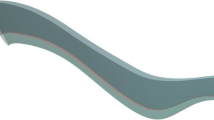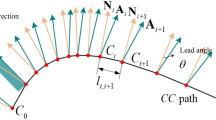Abstract
Improving the machining dynamics performance and efficiency of machine tools is extremely important to finish the processing of complex channel parts with high quality in a short time. In this paper, a three-step frame is adopted to achieve this goal by planning the tool orientations and feed rate, which includes C-spaces determination, collaborative optimization of toolpath and feed rates, and the adjustment for over-limitation dynamic parameters. Firstly, a conical ball-end cutter is used and the feasible C-spaces computation method is provided based on the envelop theory. Secondly, a multi-objective mathematical model with multi-constraint conditions for optimizing the dynamics performance and machining efficiency is built. Thirdly, the solving algorithms for the model but simplified is designed to generate the optimal toolpath and initial variable feed rate sequence. To design the efficient algorithms, the Closed-region Parametric Encoding (CPE) method for data structure and the Parametric Data Algorithm Design (PDAD) for algorithm design are proposed, which can transform the geometric constraints into the parametric surfaces in C-space and compute with the continuous parameters to implement the adaptive local subdivision. The algorithms can automatically generate the different shape of toolpath curve to obtain better optimization results. Finally, considering the dynamic parameters limitation, an adjustment algorithm is designed to adjust the feed rates for reducing the over-limitation dynamic parameters. At the end of the paper, two sets of comparative experiments are given for verification. The first set experiment shows that our approach can efficiently improve the machining dynamics performance and efficiency for complex channel parts. The second set experiment shows that the solving algorithm designed by the CPE method and PDAD method has the better computation efficiency and optimization effect.

































Similar content being viewed by others
References
Liang Y, Zhang D, Ren JX, Li XY (2016) Accessible regions of tool orientations in multi-axis milling of blisks with a ball-end mill. Int J Adv Manuf Technol 85(5–8):1887–1900
Tang TD, Bohez ELJ (2015) A new collision avoidance strategy and its integration with collision detection for five-axis NC machining. Int J Adv Manuf Technol 81(5–8):1247–1258
Lacharnay V, Lavernhe S, TournierC LC (2015) A physically-based model for global collision avoidance in 5-axis point milling. Computer-Aided Des 64:1–8
Lin Z, Shen H, Gan W, Fu J (2012) Approximate tool posture collision-free area generation for five-axis CNC finishing process using admissible area interpolation. Int J Adv Manuf Technol 62(9):1191–1203
Gilles P, Senatore J, Segonds S, Monies F, Rubio W (2012) Determination of angular fields outside low and high collisions to mill free-form surfaces on 5-axis CNC machines. Int J Prod Res 50(4):1045–1061
Wang J, Luo M, Zhang D (2018) A GPU-accelerated approach for collision detection and tool posture modification in multi-axis machining. IEEE Access 6:35132–35142
Bi QZ, Wang YH, Ding H (2010) A GPU-based algorithm for generating collision-free and orientation-smooth five-axis finishing tool paths of a ball-end cutter. Int J Prod Res 48(4):1105–1124
Ding H, Bi Q, Zhu L, Xiong Y (2010) Tool path generation and simulation of dynamic cutting process for five-axis NC machining. Chin Sci Bull 55(30):3408–3418
Ezair B, Elber G (2018) Automatic generation of globally assured collision free orientations for 5-axis ball-end tool-paths. Comput Aided Des 102(04):171–181
Lu YA, Wang CY, Sun JB, Zheng LJ (2018) Smoothing rotary axes movements for ball-end milling based on the gradient-based differential evolution method. J Manuf Sci Eng 140(12):1–10
Zhang XM, Zhang D, Cao L, Huang T, Leopold J, Ding H (2016) Minimax optimization strategy for process parameters planning: toward interference-free between tool and flexible workpiece in milling process. J Manuf Sci Eng 139(5):051010
Chen L, Xu K, Tang K (2015) Collision-free tool orientation optimization in five-axis machining of bladed disk. J Comput Des Eng 2(4):197–205
Castagnetti C, Duc E, Ray P (2008) The domain of admissible orientation concept: a new method for five-axis tool path optimization. Comput Aided Des 40(9):938–950
Plakhotnik D, Lauwers B (2014) Graph-based optimization of five-axis machine tool movements by varying tool orientation. Int J Adv Manuf Technol 74:307–318
Mi Z, Yuan CM, Ma X, Shen LY (2016) Tool orientation optimization for 5-axis machining with C-space method. Int J Adv Manuf Technol 88(5–8):1243–1255
Wang J, Zhang D, Luo M, Wu B (2013) A global tool orientation optimization method for five-axis cnc machining of sculptured surfaces. Acta Aero ET Astro Sin 34(6):1452–1462
Xu R, Cheng X, Zheng G, Chen Z (2017) A tool orientation smoothing method based on machine rotary axes for five-axis machining with ball end cutters. Int J Adv Manuf Technol 92(7):3615–3625
Sun Y, Xu J, Jin C, Guo D (2016) Smooth tool path generation for 5-axis machining of triangular mesh surface with nonzero genus. Comput Aided Des 79:60–74
Li XY, Ren JX, Liang YS, Tian XR (2014) Tool axis planning for five-axis machining of complex channel parts. Acta Aero ET Astro Sin 33(10):1920–1930
Sun Y, Bao Y, Kang K, Guo D (2013) A cutter orientation modification method for five-axis ball-end machining with kinematic constraints. Int J Adv Manuf Technol 67(9–12):2863–2874
Hu P, Tang K (2011) Improving the dynamics of five-axis machining through optimization of workpiece setup and tool orientations. Comput Aided Des 43(12):1693–1706
Zhu LM, Zhang XM, Zheng G, Ding H (2009) Analytical expression of the swept surface of a rotary cutter using the envelope theory of sphere congruence. J Manuf Sci Eng 131(4):041017
Mathews JH, Fink KD (2004) Numerical methods using MATLAB. Pearson
Gen M, Cheng R (2003) Genetic algorithms and engineering optimization. Tsinghua University Press, Beijing
Piegl LA, Tiller W (1997) The NURBS book. Springer, Berlin Heidelberg
Acknowledgments
This work is supported by the project by The National Science and Technology Major Project of China (No. JPPT-KF2016-6-1).
Author information
Authors and Affiliations
Corresponding author
Additional information
Publisher’s note
Springer Nature remains neutral with regard to jurisdictional claims in published maps and institutional affiliations.
Rights and permissions
About this article
Cite this article
Zhang, W., Ren, J. Improving the machining dynamics performance and efficiency for complex channel part manufacturing by planning the tool orientations and feed rate sequence. Int J Adv Manuf Technol 107, 3663–3689 (2020). https://doi.org/10.1007/s00170-020-05157-5
Received:
Accepted:
Published:
Issue Date:
DOI: https://doi.org/10.1007/s00170-020-05157-5




